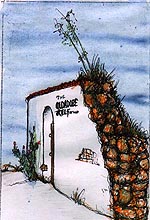|

Listen
to voice over artist Tim George

read
the part of Hank Peabody
Visit
Tim George's website to learn more
about his work
www.timgeorgevo.com
The Romance of the Missions:
THE STORY OF WILLIAM REED
AND MISSION SAN MIGUEL
72.
IN 1832, RECORDS INDICATE
that Mission San Miguel
had 2472 baptisms, 764 marriages, 1868 deaths and 658 “neophytes.”
With them were 8282 sheep, forty-two goats, fifty pigs, 700 hundred
horses and 186 mules.
Founded in 1797 by Padre
Fermín Francisco de Lasuén, taking over the mission
system upon the death of Junipero Serra,
Mission San Miguel was the last of the California missions to be secularized
in 1834.
Lasuén’s tenure doubled the number of missions
and the number of converts, introducing “mission architecture,”
with its red tile roofs and white walls. Under Serra’s tenure,
the missions had been mere holes-in-the-ground with thatched roofs.
Lasuén’s move was an important stroke. Today it would be
difficult to imagine Taco Bell, or any
of California’s mission-style shopping malls, as the thatched roof,
hole-in-the-ground establishments that Serra established at the beginning
of his reign. Junipero Serra may have founded the California mission
system, but Padre Fermín Francisco de Lasuén engineered
the Bell Beefer.
Although San Miguel was sold in 1845 and returned to the
church in 1859, its location away from what would end up being the larger
metropolitan areas of the state caused it to fall into neglect. Not
that it didn’t have its culturally significant artifacts—there
is, for instance, a cannon from the Spanish, forged in 1697, and used
against John C. Fremont and his troops in 1846—still, Mission San
Miguel remained an outpost even after the outpost status of places like
San Diego, Santa Barbara, El Fornio, Carmel and San Francisco changed
from colonial fort to vacation spot. No one wanted to live in San Miguel
it seemed, and because of that the old mission grounds went begging.
In 1846, General
Pio Pico, the governer of California—about three days from
losing the state to the Americans (hear the cannon sound?)—sold
off all of San Miguel, excepting the priest’s lodgings and the
church itself. One William Reed, the purchaser, moved his wife and two
children into a wing which they occupied for a number of months.
The area saw people come and go as they passed through the
countryside—disenfranchised Indians, Spanish Leathercoats, newly
arrived Chinese laborers, late wandering Chinese mariners, Yankees,
soldiers and gold seekers. In 1849, gold rush tramps—and they were
all tramps in the Gold Rush, make no doubt about it—came to water
their horses at the old mission. According to records, Reed entertained
them with stories, one of which involved a bit of braggadocio about
his personal store of hidden treasure. The visitors thanked him for
his hospitality and moved on. But as night fell, they doubled back,
returned to the old mission and slaughtered Reed, his family and six
servants in search of the treasure.
There was no treasure—at least none that any of them
could find. The next day, a posse caught up with the group, killing
one in the ensuing gun battle. Then, as they made their way to the coast,
one jumped into the ocean trying to escape and drowned (YMCA swim classes
were still decades away). The other three were taken as prisoners and
sent down to Santa Barbara where they were executed.
That, folks, is the romance of the missions.
More on
Mission San Miguel, with a reference
to Bill Reed and his family at Wikipedia
HERE.
|

